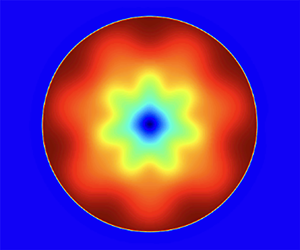Article contents
Stable and unstable supersonic stagnation of an axisymmetric rotating magnetized plasma
Published online by Cambridge University Press: 15 February 2022
Abstract

The Naval Research Laboratory ‘Mag Noh problem’, described in this paper, is a self-similar magnetized implosion flow, which contains a fast magnetohydrodynamic (MHD) outward propagating shock of constant velocity. We generalize the classic Noh (OSTI Tech. Rep. 577058, 1983) problem to include azimuthal and axial magnetic fields as well as rotation. Our family of ideal MHD solutions is five parametric, each solution having its own self-similarity index, gas gamma, magnetization, the ratio of axial to the azimuthal field and rotation. While the classic Noh problem must have a supersonic implosion velocity to create a shock, our solutions have an interesting three-parametric special case with zero initial velocity in which magnetic tension, instead of implosion flow, creates the shock at  $t=0+$. Our self-similar solutions are indeed realized when we solve the initial value MHD problem with the finite volume MHD code Athena. We numerically investigated the stability of these solutions and found both stable and unstable regions in parameter space. Stable solutions can be used to test the accuracy of numerical codes. Unstable solutions have also been widely used to test how codes reproduce linear growth, transition to turbulence and the practically important effects of mixing. Now we offer a family of unstable solutions featuring all three elements relevant to magnetically driven implosions: convergent flow, magnetic field and a shock wave.
$t=0+$. Our self-similar solutions are indeed realized when we solve the initial value MHD problem with the finite volume MHD code Athena. We numerically investigated the stability of these solutions and found both stable and unstable regions in parameter space. Stable solutions can be used to test the accuracy of numerical codes. Unstable solutions have also been widely used to test how codes reproduce linear growth, transition to turbulence and the practically important effects of mixing. Now we offer a family of unstable solutions featuring all three elements relevant to magnetically driven implosions: convergent flow, magnetic field and a shock wave.
JFM classification
- Type
- JFM Papers
- Information
- Copyright
- © The Author(s), 2022. Published by Cambridge University Press
References
REFERENCES
- 4
- Cited by





